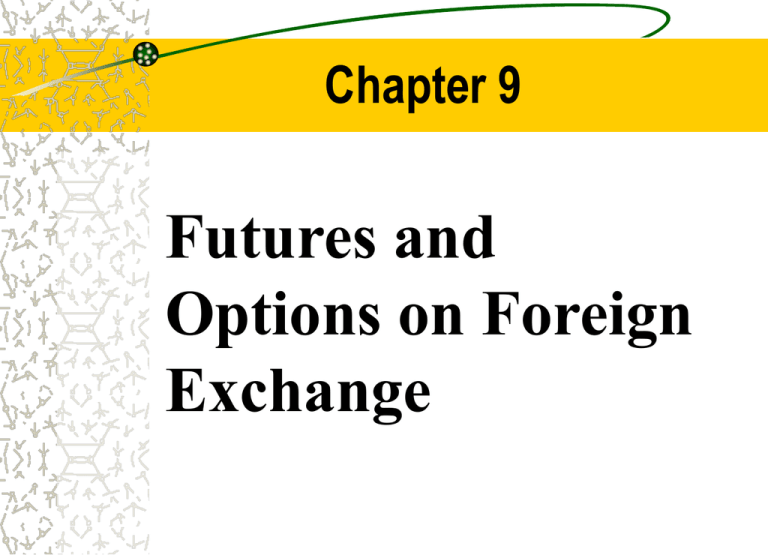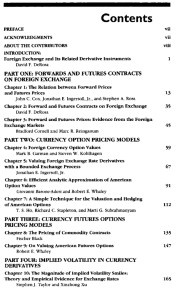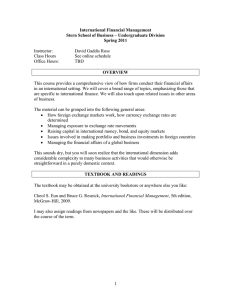Futures and Options on Foreign Exchange Chapter 9
advertisement

Chapter 9 Futures and Options on Foreign Exchange Chapter Outline Futures Contracts: Preliminaries Currency Futures Markets Basic Currency Futures Relationships Eurodollar Interest Rate Futures Contracts Options Contracts: Preliminaries Currency Options Markets Currency Futures Options Chapter Outline (continued) Basic Option Pricing Relationships at Expiry American Option Pricing Relationships European Option Pricing Relationships Binomial Option Pricing Model European Option Pricing Model Empirical Tests of Currency Option Models Futures Contracts: Preliminaries A futures contract is like a forward contract: – It specifies that a certain currency will be exchanged for another at a specified time in the future at prices specified today. A futures contract is different from a forward contract: – Futures are standardized contracts trading on organized exchanges with daily resettlement through a clearinghouse. Futures Contracts: Preliminaries Standardizing Features: – Contract Size – Delivery Month – Daily resettlement Initial Margin (about 4% of contract value, cash or T-bills held in a street name at your brokers). Daily Resettlement: An Example Suppose you want to speculate on a rise in the $/¥ exchange rate (specifically you think that the dollar will appreciate). Japan (yen) 1-month forward 3-months forward 6-months forward U.S. $ equivalent Wed Tue 0.007142857 0.007194245 0.006993007 0.007042254 0.006666667 0.006711409 0.00625 0.006289308 Currency per U.S. $ Wed Tue 140 139 143 142 150 149 160 159 Currently $1 = ¥140. The 3-month forward price is $1=¥150. Daily Resettlement: An Example Currently $1 = ¥140 and it appears that the dollar is strengthening. If you enter into a 3-month futures contract to sell ¥ at the rate of $1 = ¥150 you will make money if the yen depreciates. The contract size is ¥12,500,000 Your initial margin is 4% of the contract value: $1 $3,333.33 .04 ¥12,500,000 ¥150 Daily Resettlement: An Example If tomorrow, the futures rate closes at $1 = ¥149, then your position’s value drops. Your original agreement was to sell ¥12,500,000 and receive $83,333.33 But now ¥12,500,000 is worth $83,892.62 $1 $83,892.62 ¥12,500,000 ¥149 You have lost $559.28 overnight. Daily Resettlement: An Example The $559.28 comes out of your $3,333.33 margin account, leaving $2,774.05 This is short of the $3,355.70 required for a new position. $1 $3,355.70 .04 ¥12,500,000 ¥149 Your broker will let you slide until you run through your maintenance margin. Then you must post additional funds or your position will be closed out. This is usually done with a reversing trade. Currency Futures Markets The Chicago Mercantile Exchange (CME) is by far the largest. Others include: – – – – The Philadelphia Board of Trade (PBOT) The MidAmerica commodities Exchange The Tokyo International Financial Futures Exchange The London International Financial Futures Exchange The Chicago Mercantile Exchange Expiry cycle: March, June, September, December. Delivery date 3rd Wednesday of delivery month. Last trading day is the second business day preceding the delivery day. CME hours 7:20 a.m. to 2:00 p.m. CST. CME After Hours Extended-hours trading on GLOBEX runs from 2:30 p.m. to 4:00 p.m dinner break and then back at it from 6:00 p.m. to 6:00 a.m. CST. Singapore International Monetary Exchange (SIMEX) offer interchangeable contracts. There’s other markets, but none are close to CME and SIMEX trading volume. Basic Currency Futures Relationships Open Interest refers to the number of contracts outstanding for a particular delivery month. Open interest is a good proxy for demand for a contract. Some refer to open interest as the depth of the market. The breadth of the market would be how many different contracts (expiry month, currency) are outstanding. Reading a Futures Quote Open Hi Lo Settle Change Lifetime High Sept .9282 .9325 .9276 .9309 +.0027 1.2085 Lifetime Low Open Interest .8636 74,639 Highest and lowest Daily Change prices over the Closing price lifetime of the Lowest price that day contract. Highest price that day Opening price Number of open contracts Expiry month Eurodollar Interest Rate Futures Contracts Widely used futures contract for hedging short-term U.S. dollar interest rate risk. The underlying asset is a hypothetical $1,000,000 90-day Eurodollar deposit—the contract is cash settled. Traded on the CME and the Singapore International Monetary Exchange. The contract trades in the March, June, September and December cycle. Reading Eurodollar Futures Quotes EURODOLLAR (CME)—$1 million; pts of 100% July Open High Low Settle Chg Yield Settle Change Open Interest 94.69 94.69 94.68 94.68 -.01 5.32 47,417 +.01 Eurodollar futures prices are stated as an index number of three-month LIBOR calculated as F = 100 – LIBOR. The closing price for the July contract is 94.68 thus the implied yield is 5.32 percent = 100 – 98.68 The change was .01 percent of $1 million representing $100 on an annual basis. Since it is a 3-month contract one basis point corresponds to a $25 price change. Options Contracts: Preliminaries An option gives the holder the right, but not the obligation, to buy or sell a given quantity of an asset in the future, at prices agreed upon today. Calls vs. Puts – Call options gives the holder the right, but not the obligation, to buy a given quantity of some asset at some time in the future, at prices agreed upon today. – Put options gives the holder the right, but not the obligation, to sell a given quantity of some asset at some time in the future, at prices agreed upon today. Options Contracts: Preliminaries European vs. American options – European options can only be exercised on the expiration date. – American options can be exercised at any time up to and including the expiration date. – Since this option to exercise early generally has value, American options are usually worth more than European options, other things equal. Options Contracts: Preliminaries In-the-money – The exercise price is less than the spot price of the underlying asset. At-the-money – The exercise price is equal to the spot price of the underlying asset. Out-of-the-money – The exercise price is more than the spot price of the underlying asset. Options Contracts: Preliminaries Intrinsic Value – The difference between the exercise price of the option and the spot price of the underlying asset. Speculative Value – The difference between the option premium and the intrinsic value of the option. Option Premium = Intrinsic Value + Speculative Value Currency Options Markets PHLX HKFE 20-hour trading day. OTC volume is much bigger than exchange volume. Trading is in seven major currencies plus the euro against the U.S. dollar. PHLX Currency Option Specifications Currency Australian dollar British pound Canadian dollar Euro Japanese yen Swiss franc Contract Size AD50,000 £31,250 CD50,000 €62,500 ¥6,250,000 SF62,500 Currency Futures Options Are an option on a currency futures contract. Exercise of a currency futures option results in a long futures position for the holder of a call or the writer of a put. Exercise of a currency futures option results in a short futures position for the seller of a call or the buyer of a put. If the futures position is not offset prior to its expiration, foreign currency will change hands. Basic Option Pricing Relationships at Expiry At expiry, an American call option is worth the same as a European option with the same characteristics. If the call is in-the-money, it is worth ST – E. If the call is out-of-the-money, it is worthless. CaT = CeT = Max[ST - E, 0] Basic Option Pricing Relationships at Expiry At expiry, an American put option is worth the same as a European option with the same characteristics. If the put is in-the-money, it is worth E - ST. If the put is out-of-the-money, it is worthless. PaT = PeT = Max[E - ST, 0] Basic Option Profit Profiles Profit If the call is in-themoney, it is worth ST – E. Long 1 call If the call is out-ofthe-money, it is worthless and the –c0 buyer of the call loses his entire investment of c0. loss ST E + c0 E Basic Option Profit Profiles Profit If the call is in-themoney, the writer loses ST – E. If the call is out-of- c 0 the-money, the writer keeps the option premium. ST E + c0 E loss short 1 call Basic Option Profit Profiles Profit If the put is inthe-money, it is E – p 0 worth E –ST. The maximum gain is E – p0 If the put is outof-the-money, it is worthless and – p0 the buyer of the put loses his entire investment of p0. loss ST E – p0 E long 1 put Basic Option Profit Profiles If the put is inthe-money, it is worth E –ST. The maximum loss is – E + p0 Profit p0 If the put is outof-the-money, it is worthless and the seller of the put keeps the option premium – E + p0 of p0. loss ST E – p0 E long 1 put Example Profit Consider a call option on £31,250. The option premium is $0.25 per pound The exercise price is $1.50 per pound. Long 1 call on 1 pound ST –$0.25 $1.75 $1.50 loss Example Profit Consider a call option on £31,250. The option premium is $0.25 per pound The exercise price is $1.50 per pound. Long 1 call on £31,250 ST –$7,812.50 $1.75 $1.50 loss Example Profit What is the maximum gain on this put option? $42,187.50 $42,187.50 = £31,250×($1.50 – $0.15)/£ At what exchange rate do you break even? Consider a put option on £31,250. The option premium is $0.15 per pound –$4,687.50 The exercise price is $1.50 per pound. loss ST $1.35 $1.50 Long 1 put on £31,250 $4,687.50 = £31,250×($0.15)/£ American Option Pricing Relationships With an American option, you can do everything that you can do with a European option—this option to exercise early has value. CaT > CeT = Max[ST - E, 0] PaT > PeT = Max[E - ST, 0] Market Value, Time Value and Intrinsic Value for an American Call Profit The red line shows the payoff at maturity, not profit, of a call option. Long 1 call Note that even an outof-the-money option has value—time value. Intrinsic value Time value Out-of-the-money loss In-the-money E ST European Option Pricing Relationships Consider two investments 1 Buy a European call option on the British pound futures contract. The cash flow today is – Ce 2 Replicate the upside payoff of the call by 1 Borrowing the present value of the exercise price of the call in the U.S. at i$ The cash flow today is E /(1 + i$) 2 Lending the present value of ST at i£ The cash flow is – ST /(1 + i£) European Option Pricing Relationships When the option is in-the-money both strategies have the same payoff. When the option is out-of-the-money it has a higher payoff than the borrowing and lending strategy. ST E Thus: Ce max ,0 (1 i£ ) (1 i$ ) European Option Pricing Relationships Using a similar portfolio to replicate the upside potential of a put, we can show that: E ST Pe max ,0 (1 i$ ) (1 i£ ) Binomial Option Pricing Model Imagine a simple world where the dollar-euro exchange rate is S0($/€) = $1 today and in the next year, S1($/€) is either $1.1 or $.90. S0($/€) S1($/€) $1.10 $1 $.90 Binomial Option Pricing Model A call option on the euro with exercise price S0($/€) = $1 will have the following payoffs. S0($/€) S1($/€) $1.10 C1($/€) $.10 $1 $.90 $0 Binomial Option Pricing Model We can replicate the payoffs of the call option. With a levered position in the euro. S0($/€) S1($/€) $1.10 C1($/€) $.10 $1 $.90 $0 Binomial Option Pricing Model Borrow the present value of $.90 today and buy €1. Your net payoff in one period is either $.2 or $0. S0($/€) S1($/€) debt portfolio C1($/€) $1.10 –$.90 $.20 $.10 $1 $.90 –$.90 $.00 $0 Binomial Option Pricing Model The portfolio has twice the option’s payoff so the portfolio is worth twice the call option value. S0($/€) S1($/€) debt portfolio C1($/€) $1.10 –$.90 $.20 $.10 $1 $.90 –$.90 $.00 $0 Binomial Option Pricing Model The portfolio value today is today’s value of one euro less the present value of a $.90 debt: S0($/€) $.90 $1 (1 i$ ) S1($/€) debt portfolio C1($/€) $1.10 –$.90 $.20 $.10 $1 $.90 –$.90 $.00 $0 Binomial Option Pricing Model We can value the option as half 1 $.90 C0 $1 of the value of the portfolio: 2 (1 i$ ) S0($/€) S1($/€) debt portfolio C1($/€) $1.10 –$.90 $.20 $.10 $1 $.90 –$.90 $.00 $0 Binomial Option Pricing Model The most important lesson from the binomial option pricing model is: the replicating portfolio intuition. Many derivative securities can be valued by valuing portfolios of primitive securities when those portfolios have the same payoffs as the derivative securities. European Option Pricing Formula We can use the replicating portfolio intuition developed in the binomial option pricing formula to generate a faster-to-use model that addresses a much more realistic world. European Option Pricing Formula C0 [ F N (d1 ) E N (d2 )]er$T The model is Where C0 = the value of a European option at time t = 0 F St e( r$ r£ )T r$ = the interest rate available in the U.S. r£ = the interest rate available in the foreign country—in this case the U.K. ln( F / E ) .5 2T d1 , d 2 d1 T T European Option Pricing Formula Find the value of a six-month call option on the British pound with an exercise price of $1.50 = £1 The current value of a pound is $1.60 The interest rate available in the U.S. is r$ = 5%. The interest rate in the U.K. is r£ = 7%. The option maturity is 6 months (half of a year). The volatility of the $/£ exchange rate is 30% p.a. Before we start, note that the intrinsic value of the option is $.10—our answer must be at least that. European Option Pricing Formula Let’s try our hand at using the model. If you have a calculator handy, follow along. First calculate F St e( r$ r£ )T 1.50e(.05.07)0.50 1.485075 Then, calculate d1 and d2 ln( F / E ) .5 2T ln( 1.485075 / 1.50) .5(0.4) 2 .5 d1 0.106066 T .4 .5 d 2 d1 T 0.106066 .4 .5 0.176878 European Option Pricing Formula F 1.485075 d1 0.106066 d2 0.176878 N(d1) = N(0.106066) = .5422 N(d2) = N(-0.1768) = 0.4298 C0 [ F N (d1 ) E N (d2 )]er$T C0 [1.485075 .5422 1.50 .4298]e .05*.5 $0.157 Option Value Determinants 1. 2. 3. 4. 5. 6. Call Put Exchange rate + – Exercise price – + Interest rate in U.S. + – Interest rate in other country + – Variability in exchange rate + + Expiration date + + The value of a call option C0 must fall within max (S0 – E, 0) < C0 < S0. The precise position will depend on the above factors. Empirical Tests The European option pricing model works fairly well in pricing American currency options. It works best for out-of-the-money and at-the-money options. When options are in-the-money, the European option pricing model tends to underprice American options.




